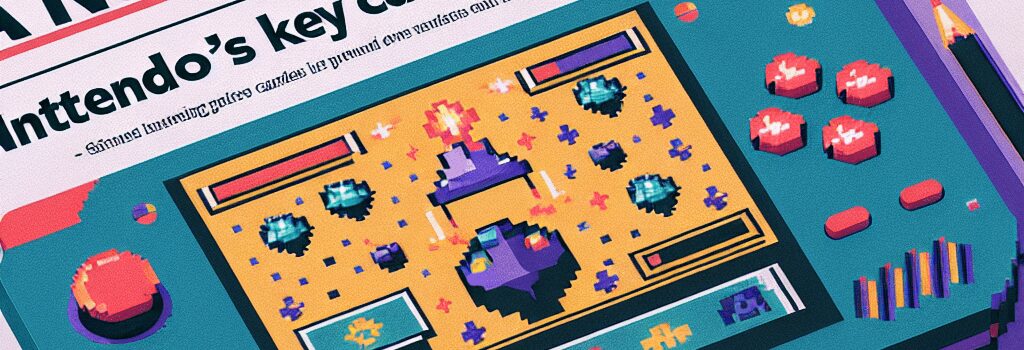A Nuanced Defense: Nintendo’s Game-Key Cards in the Digital Age

Introduction
Nintendo’s recent barrage of Switch 2 announcements has introduced a twist to physical game media: the Game-Key card. Though these cards differ from traditional game cartridges by using a stored download key rather than actual game data, they offer a compromise between full digital downloads and classic physical media. In this article, we delve deeper into the technical aspects, market impacts, and long-term implications of this approach.
The Evolution of Game Distribution
Historically, physical game releases meant that the game either booted right from the media or required minimal patching. With the introduction of digital downloads and online content distribution, players have had to adjust to waiting times and significant storage requirements. The Game-Key card system reflects this evolution: physical packaging that merely acts as a trigger for downloading the actual game from Nintendo’s high-speed servers.
- Download Trigger: The inserted key instructs the console to fetch the game data from Nintendo’s servers, creating a hybrid model that retains physical originality while relying on digital content delivery.
- Transferrable Ownership: Unlike digital codes that are often tied to a Nintendo Account, a Game-Key card remains transferrable, making it easier to share or resell, ensuring that the physical media still holds intrinsic value.
Technical Specifications and Digital Architecture
The Game-Key card technology offers fascinating insights into modern digital rights management (DRM) mechanisms. Unlike a simple download code, the card’s embedded key works seamlessly across multiple devices. Once the game data is downloaded, it will run only when the hardware detects the key on the card. This system is reminiscent of DRM practices in PC gaming before platforms like Steam provided streamlined digital libraries. However, here are a few technical nuances:
- Data Integrity and Verification: The card acts as a physical token that confirms game ownership, triggering a server-side check to validate the download. This secure handshake ensures that even if the same data is loaded on different consoles within the same household, the validation remains consistent.
- Storage Demands: All game data must reside on the device’s internal storage or on a microSD Express card, a high-speed storage solution intended to counteract prolonged download times. With limited internal storage (typically 256GB on the Switch 2), users might need innovative storage management or additional microSD Express cards to accommodate larger titles.
- Server Dependency: The system’s reliance on Nintendo’s servers means that every new console transition or game reinstallation requires a full re-download of the content, potentially heightening the load on network infrastructure during peak times.
Market Impact and Consumer Flexibility
Consumer reaction to the Game-Key card model has been polarized. Some enthusiasts lament the inconvenience of having to re-download large game files, especially when swapping consoles or sharing games among family members and friends. Traditional physical game cards allow immediate play, bypassing lengthy downloads and preserving precious storage space.
On the other hand, proponents appreciate the retention of a physical object that encapsulates ownership. This system allows users to:
- Lend a game to a friend without transferring account ownership.
- Resell or trade the physical card in secondary markets, thereby recapturing a portion of the original value.
Experts argue that while digital distribution has its merits, physical media still plays a crucial role in the tangible aspects of game ownership and the cultural practice of sharing and reselling. This balance might help stave off the pitfalls of an entirely digital ecosystem where ownership is reduced to a license rather than a transferable asset.
Preservation Challenges and Future Outlook
The conversation about digital preservation is increasingly relevant as companies gradually phase out or modify their distribution models. In 2023, Nintendo’s decision to shut down servers for older consoles like the Wii U and 3DS brought long-term preservation and access issues into sharp focus. With the Game-Key card model for the Switch 2, similar challenges may arise:
- Longevity Concerns: If Nintendo were ever to shut down the servers required to authenticate and download games, a Game-Key card could become an obsolete token compared to a traditional game cartridge that holds all the necessary data.
- Game Preservation: Digital downloads, no matter how advanced, might not serve the interests of collectors and digital archivists. Physical media inherently provide redundancy and longevity that digital-only formats lack, especially when future access depends on server maintenance and proprietary protocols.
Looking forward, experts in digital preservation and gaming hardware advocate for hybrid models that prioritize consumer rights and long-term access. As technology evolves, solutions may include local backup options, more robust DRM-free backup policies, or even a return to more self-contained physical media formats.
Concluding Thoughts
While the introduction of Game-Key cards for the Switch 2 presents well-founded challenges, they still mark a significant improvement over download-only releases. By preserving a tangible aspect of game ownership, Nintendo maintains a bridge between the digital and physical realms. The hybrid model may not be perfect, especially in a market increasingly dominated by digital distribution, but it offers gamers the flexibility of transferable ownership and a reminder of how physical media once defined the culture of gaming.
Ultimately, the debate is more than just about technology—it’s about preserving a sense of ownership, experience, and community among gamers in a rapidly digitizing world. As new technologies and solutions evolve, both consumers and companies will need to navigate these challenges, ensuring that the future of gaming remains as innovative as it is accessible.